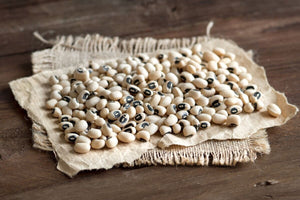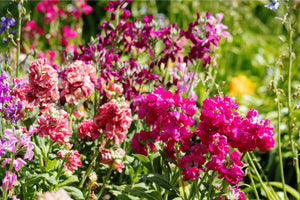How to Grow Long-Lasting, Fragrant, Heirloom Carnations
CarnationsThere’s a reason carnations are one of the most popular vintage flowers. These heirloom favorites are fragrant, easy to grow, and have an incredibly long vase life. Carnations have been the faithful flowers in corsages, boutonnieres, and a variety of floral arrangements for generations. Learn how easy it is to grow carnations in your garden.

Carnations are the perfect flower for flower farms and cottage gardens. Second only to roses in popularity, carnations are an old favorite. These drought-resistant flowers are low maintenance and can be grown as perennials in growing zones with moderate winters.
Chabaud Blend Carnations make elegant cut flowers, thanks to their long, straight stems and fragrant, showy blooms that last a long time. These heirloom flowers can be grown as annuals in zones where winters are cold, or they can be hardy perennials in zones without frost. The Chabaud Blend will bloom in a range of gorgeous hues of red, pink, yellow, and orange.
How to Grow Carnations from Seed
Carnations are easy to grow from seed. Keep seeds moist and warm for optimal germination.
Carnation seeds can be started indoors or directly sown in the ground after the last frost. For the best blooms in the first year, starting seeds indoors is recommended.

Tips for starting carnation seeds indoors
Start carnations seeds indoors 6-8 weeks before the last frost date.
Press seeds into seed starting mix. Seeds should only be ⅛” deep.
Moisten the soil with a spray bottle and use a humidity dome to keep the seeds moist until they sprout in 7 to 14 days.
The optimal soil temperature for seed germination is 65-70ºF.
When seedlings emerge, move them to a cool, bright place.
Keep grow lights close to the seedlings to keep them from growing leggy as they reach for the light.
Once seedlings reach 2 to 3 inches tall, harden off and transplant to a fertile, well-drained spot.
Transplanting Carnation Seedlings
When seedlings are about 3 inches tall and have at least two sets of true leaves, you can start the process of transplanting.
For successful transplanting, first, slowly harden off the carnation seedlings to avoid transplant shock. Place plants in a sheltered place outdoors for 1 hour. Each day, increase the outdoor time by one hour. Once the carnation seedlings are hardened off, and all danger of frost has passed, the carnations can be transplanted outdoors.
Prepare the soil before transplanting. Ensure that it is well-draining and nutrient-rich. Heavy clay soil will need to be amended before transplanting.
Space carnation plants 12 to 18 inches apart. Dig a hole and place the carnation plant to the depth that it was already growing.

Direct Sowing Carnation Seeds Outdoors
Carnation seeds can be sown outdoors in the ground once all danger of frost has passed. These direct-sown carnations may not produce flowers in the first year. However, if grown in a mild growing zone, they will be perennials and come back up in the spring.
Sow seeds ¼” deep and keep seeds moist until they sprout. Thin as needed to keep them 12 to 18” apart.
How to Grow Carnation Flowers
Soil
Grow carnations in fertile, well-draining soil. This is crucial since carnation plants will die of root rot when the soil is too soggy. You will need to amend clay soil before planting carnations. A slightly alkaline soil of 6.7 is preferable.
Sun
Carnations need full sun to grow to their full potential. This means at least 6 hours of daily direct sunlight. Carnations prefer cooler temperatures. In hotter climates, afternoon shade can be beneficial as long as they still get enough sun.
Water
Young carnation plants need consistent water until they have a well-established root system. Once carnations have a healthy root system, they are somewhat drought-resistant. The soil can dry out between watering. It is crucial that the soil drains well so that the roots don’t remain water-logged. Wet roots will result in root rot. Usually, an inch of water once a week is sufficient. In containers or hotter climates, more frequent watering may be needed to keep carnations blooming.
Fertilizing
Carnation flowers are not heavy feeders. With nutrient-rich soil, they don’t need additional fertilizers. But when growing carnations as perennials, you will want to add a yearly application of a balanced, slow-release fertilizer. Too much fertilizer can have the opposite effect you want and stunt the growth.
Deadheading and Pruning
For a longer production of blooms, keep carnation flowers deadheaded. This means to remove flowers before they have completely died off. When flowers are left on the plant to go to seed, the plant will stop producing new blooms.
Carnation plants can also be cut halfway back in the summer for another growth of blooms in the fall.

Harvesting Carnation Flowers
Carnations are the second most popular cut flower. They are prized among flower growers for their long vase life.
As with other flowers for indoor arrangements, cut carnations in the early morning while they are still fresh. For a longer vase life, cut blooms before they are fully open.
Solutions for carnation pests and diseases
Carnations don’t have too many problems with pests. Their fragrant flowers are not appealing to deer.
Natural methods can control aphids and thrips. Neem oil can also be effective against infestations.
Sufficient airflow and targeted watering to keep the leaves and flowers dry will help prevent fungal problems. Water carnation plants at the roots and avoid overhead watering. Keeping plants trimmed and spaced far enough apart can improve airflow, which is especially important in high-humidity areas.
Carnation FAQs
Are carnations edible?
The Chabaud varieties are edible and have a spicy taste.
Can you grow carnations in pots?
Carnations are a beautiful addition to container flower gardens. Follow the same growing recommendations for growing carnations inground.
Do carnations bloom the first year?
Start seeds indoors for blooms in the first year. Sow seeds eight weeks before the last frost date.
If you’ve only experienced florist carnations, it’s time to get to know garden carnations. They aren’t as fussy as some other flowers, and they are very fragrant with a long vase life.
These frilly blooms are easy to grow and incredibly fragrant. Although often viewed as “old-fashioned,” carnations are vibrant heirloom flowers that will be a beautiful addition to your borders, cottage garden, or flower farm. Add carnations to your garden plan this year.
Written by Beverly Laudie







Leave a comment